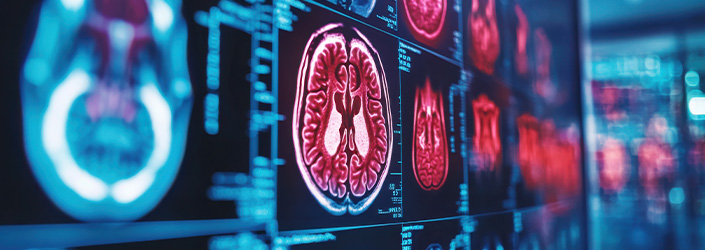Towards the augmented diagnostics of the future
This project is about developing a new diagnostic paradigm where computers will help clinicians and surgeons in their decision-making to ensure the best treatment of patients affected by brain tumours.
Project sponsor: National Health and Medical Research Centre (NHMRC) Ideas Grant

About the project
This work applies computer models, including Artificial Intelligence techniques, to augment expert diagnosis of brain tumours with the aim of:
- better predicting patients’ prognosis
- optimising their treatment
- improving their outcomes.
Project lead: Professor Antonio Di Ieva
- Honorary Professor Benolt Liquet-Welland
- Dr Sidong Liu
- Greg Savage
2025
- Diagnostic accuracy of deep learning models in predicting glioma molecular markers: a systematic review and meta-analysis
- Synthetic [18F]FET-PET generation and hotspot prediction via preoperative MRI of glioma lacking radiographic high-grade characteristics
- Synthetic O-(2-18F-fluoroethyl)-L-tyrosine-positron emission tomography generation and hotspot prediction via preoperative MRI fusion of gliomas lacking radiographic high-grade characteristics
2024
- AI in neuro-oncology: predicting EGFR amplification in glioblastoma from Whole Slide Images using Weakly Supervised Deep Learning
- Artificial intelligence in brain tumors
- Artificial intelligence methods
- Computational neurosurgery: Foundation
- Computer vision in digital neuropathology
- Cross-modality synthesis of T1c MRI from non-contrast images using GANs: implications for brain tumor research
- Declaration of computational neurosurgery
- Meta-transfer learning for brain tumor segmentation: within and beyond glioma
- Meta-transfer learning for few-shot meningioma segmentation
- Synthetic [18F]FET-PET generation and hotspot prediction via preoperative MRI of glioma lacking radiographic high-grade characteristics
- Towards machine learning-based quantitative hyperspectral image guidance for brain tumor resection
- Use of artificial intelligence in the prediction of Chiari malformation type 1 recurrence after posterior fossa decompressive surgery
2023
- A Deep Learning Framework for skull stripping in brain MRI
- Artificial intelligence–assisted classification of gliomas using whole-slide images
- Attention-based deep learning approaches in brain tumor image analysis: a mini review
- Domain-specific pre-training improves confidence in whole slide image classification
- Machine learning-based spectroscopic tissue differentiation in fluorescence-guided neurosurgery
- Radiomics and machine learning in brain tumors and their habitat: a systematic review
2022
- Artificial intelligence for survival prediction in brain tumors on neuroimaging
- Foundations of multiparametric brain tumor imaging characterization using machine learning
- Spherical coordinates transformation pre-processing in Deep Convolution Neural Networks for brain tumor segmentation in MRI
- Use of deep learning in the MRI diagnosis of Chiari malformation type I
2021
- Application of deep learning for automatic segmentation of brain tumors on magnetic resonance imaging: a heuristic approach in the clinical scenario
- Computational Neurosurgery in brain tumors: a paradigm shift on the use of artificial intelligence and connectomics in pre- and intra-operative imaging
- Impact of spherical coordinates transformation pre-processing in Deep Convolution Neural Networks for brain tumor segmentation and survival prediction
- Machine learning for the prediction of molecular markers in glioma on magnetic resonance imaging: a systematic review and meta-analysis
2020
2019
Collaborative partners include:
- Macquarie Medical School
- University of New South Wales
- Centre for Health Informatics
- School of Mathematical and Physical Sciences
- Omniscent Neurotecnology Pty Limited
- Douglass Hanly Moir Pathology
- School of Psychological Sciences.